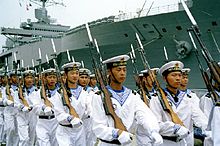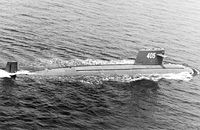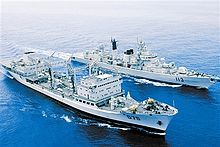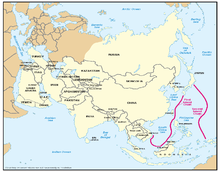- People's Liberation Army Navy
-
中国人民解放军海军
People's Liberation Army Navy
Active since September 1950 Country China Size 250,000 personnel
1 Aircraft carrier
1 Amphibious transport dock (LPD)
25 Destroyers
47 Frigates
63 Submarines
30 Landing Ship Tank (LST)
58 Landing Ship Medium (LSM)Engagements Chinese Civil War
Sino-Vietnamese War
Anti-Piracy in SomaliaCommanders Current
commanderAdmiral Wu Shengli The People's Liberation Army Navy (PLAN or PLA Navy) (simplified Chinese: 中国人民解放军海军; traditional Chinese: 中國人民解放軍海軍; pinyin: Zhōngguó Rénmín Jiěfàngjūn Hǎijūn) is the naval branch of the People's Liberation Army (PLA), the military of the People's Republic of China. Until the early 1990s, the navy performed a subordinate role to the PLA Land Forces. Since then, it has undergone rapid modernisation. It is currently the second largest naval service in the world. With a personnel strength of over 250,000, the PLAN also includes the 35,000 strong Coastal Defense Force and the 56,000 man Naval infantry/Marines, plus a 56,000 PLAN Aviation naval air arm operating several hundred land-based aircraft and ship-based helicopters. As part of its overall program of naval modernization, the PLAN has a plan of developing a blue-water navy.[1]
Contents
Mission
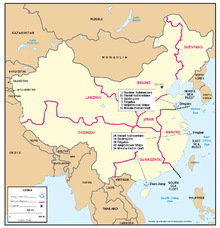 Major Naval Units in PLA Military Regions in 2006 (Source: US DOD) - click to enlarge.
Major Naval Units in PLA Military Regions in 2006 (Source: US DOD) - click to enlarge.
Peacetime:
- Sea patrols of territorial waters
- Establish presence in disputed territorial waters and protect current interests
- Anti-piracy, anti-smuggling, search and rescue
- Maintain security of territorial waters
- Active logistical support role of combatants and island garrisons
- Maintain security of Sea Lines of Communications
Wartime:
- Littoral defense of local seas
- Blockade or protection of vital ship routes and choke points
- Tactical transport, support, and amphibious operations of ground forces
- Air defense
- Anti-submarine operations
- Engagement of enemy shipping
- Active logistical support role of combatants and island garrisons
History
See also: Naval history of China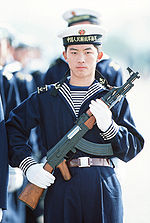 A Chinese sailor, armed with a Type 56 assault rifle in 1986.
A Chinese sailor, armed with a Type 56 assault rifle in 1986.
The PLAN traces its lineage to units of the Republic of China Navy who defected to the People's Liberation Army towards the end of the Chinese Civil War. In 1949, Mao Zedong asserted that "to oppose imperialist aggression, we must build a powerful navy." During the Landing Operation on Hainan Island, the communists used wooden junks fitted with mountain guns as both transport and warships against the Republic of China Navy. The Naval Academy was set up at Dalian on 22 November 1949, mostly with Soviet instructors. The navy was established in September 1950 by consolidating regional naval forces under General Staff Department command in Jiangyan, now in Taizhou, Jiangsu province. It then consisted of a motley collection of ships and boats acquired from the Kuomintang forces. The Naval Air Force was added two years later. By 1954 an estimated 2,500 Soviet naval advisers were in China—possibly one adviser to every thirty Chinese naval personnel—and the Soviet Union began providing modern ships. With Soviet assistance, the navy reorganized in 1954 and 1955 into the North Sea Fleet, East Sea Fleet, and South Sea Fleet, and a corps of admirals and other naval officers was established from the ranks of the ground forces. In shipbuilding the Soviets first assisted the Chinese, then the Chinese copied Soviet designs without assistance, and finally the Chinese produced vessels of their own design. Eventually Soviet assistance progressed to the point that a joint Sino-Soviet Pacific Ocean fleet was under discussion.
1950s and 1960s
Through the upheavals of the late 1950s and 1960s the Navy remained relatively undisturbed. Under the leadership of Minister of National Defense Lin Biao, large investments were made in naval construction during the frugal years immediately after the Great Leap Forward. During the Cultural Revolution, a number of top naval commissars and commanders were purged, and naval forces were used to suppress a revolt in Wuhan in July 1967, but the service largely avoided the turmoil affecting the country. Although it paid lip service to Mao and assigned political commissars aboard ships, the Navy continued to train, build, and maintain the fleets.
1970s and 1980s
In the 1970s, when approximately 20 percent of the defense budget was allocated to naval forces, the Navy grew dramatically. The conventional submarine force increased from 35 to 100 boats, the number of missile-carrying ships grew from 20 to 200, and the production of larger surface ships, including support ships for oceangoing operations, increased. The Navy also began development of nuclear-powered attack submarines (SSN) and nuclear-powered ballistic missile submarines (SSBN).
In the 1980s, under the leadership of Chief Naval Commander Liu Huaqing, the navy developed into a regional naval power, though naval construction continued at a level somewhat below the 1970s rate. Liu Huaqing was an Army Officer who spent most of his career in administrative positions involving science and technology.
It was not until 1988 that the People's Liberation Army Navy was led by a Naval Officer. Liu was also very close to Deng Xiaoping as his modernization efforts were very much in keeping with Deng's national policies. While under his leadership Naval construction yards produced fewer ships than the 1970s, greater emphasis was placed on technology and qualitative improvement.
Modernization efforts also encompassed higher educational and technical standards for personnel; reformulation of the traditional coastal defense doctrine and force structure in favor of more green-water operations; and training in naval combined-arms operations involving submarine, surface, naval aviation, and coastal defense forces.
Examples of the expansion of China's capabilities were the 1980 recovery of an intercontinental ballistic missile (ICBM) in the Western Pacific by a twenty-ship fleet, extended naval operations in the South China Sea in 1984 and 1985, and the visit of two naval ships to three South Asian nations in 1985. In 1982 the navy conducted a successful test of an underwater-launched ballistic missile. The navy also had some success in developing a variety of surface-to-surface and air-to-surface missiles, improving basic capabilities.[2]
In 1986 the Navy's order of battle included two Xia-class SSBNs armed with twelve CSS-N-3 missiles and three Han-class SSNs armed with six SY-2 cruise missiles. In the late 1980s, major deficiencies reportedly remained in antisubmarine warfare, mine warfare, naval electronics (including electronic countermeasures equipment), and naval aviation capabilities.
The PLA Navy was ranked in 1987 as the third largest navy in the world, although naval personnel had comprised only 12 percent of PLA strength. In 1987 the Navy consisted (as it does now) of the naval headquarters in Beijing; three fleet commands – the North Sea Fleet, based at Qingdao, Shandong; the East Sea Fleet, based at Ningbo; and the South Sea Fleet, based at Zhanjiang, Guangdong – and about 2,000 ships. The 350,000-person Navy included Naval Air Force units of 34,000 men, the Coastal Defense Forces of 38,000, and the Marine Corps of 56,500. Navy Headquarters, which controlled the three fleet commands, was subordinate to the PLA General Staff Department. In 1987, China's 1,500 km coastline was protected by more than 100 diesel-powered Romeo- and Whiskey-class submarines, which could remain at sea only a limited time. Inside this protective ring and within range of shore-based aircraft were destroyers and frigates mounting Styx anti-ship missiles, depth-charge projectors, and guns up to 130 mm. Any invader penetrating the destroyer and frigate protection would have been swarmed by almost 900 fast-attack craft. Stormy weather limited the range of these small boats, however, and curtailed air support. Behind the inner ring were Coastal Defense Force personnel operating naval shore batteries of Styx missiles and guns, backed by ground force units deployed in depth.
Into the 21st century
As the 21st century approached, the PLAN began to transition to an off-shore defensive strategy that entailed more out-of-area operations away from its traditional territorial waters.[3] Between 1989 and 1993, the training ship Zhenghe paid ports visits to Hawaii, Thailand, Bangladesh, Pakistan, and India. PLAN vessels visited Vladivostok in 1993, 1994, 1995, and 1996. PLAN task groups also paid visits to Indonesia in 1995; North Korea in 1997; New Zealand, Australia, and the Philippines in 1998; Malaysia, Tanzania, South Africa, the United States, and Canada in 2000; and India, Pakistan, France, Italy, Germany, Britain, Hong Kong, Australia, and New Zealand in 2001.[4]
In March 1997, the Luhu-class guided missile destroyer Harbin, the Luda-class guided missile destroyer Zhuhai, and the replenishment oiler Nancang began the PLA Navy's first circumnavigation of the Pacific Ocean, a 98-day voyage with port visits to Mexico, Peru, Chile, and the United States, including Pearl Harbor and San Diego. The flotilla was under the command of Vice Admiral Wang Yongguo, the commander-in-chief of the South Sea Fleet.[4][5][6][7][8][9]
The Luhu-class guided missile destroyer Qingdao and the replenishment oiler Taicang completed the PLA Navy's first circumnavigation of the world (pictured), a 123-day voyage covering 32,000 nautical miles (59,000 km; 37,000 mi) between 15 May – 23 September 2002. Port visits included Changi, Singapore; Alexandria, Egypt; Aksis, Turkey; Sevastopol, Ukraine; Piraeus, Greece; Lisbon, Portugal; Fortaleza, Brazil; Guayaquil, Ecuador; Callao, Peru; and Papeete in French Polynesia. The PLA naval vessels participated in naval exercises with the French frigates Nivôse and Prairial, as well as exercises with the Peruvian Navy. The flotilla was under the command of Vice Admiral Ding Yiping, the commander-in-chief of the North Sea Fleet, and Captain Li Yujie was the commanding officer of the Qingdao.[10][11][12][13][14][15][16]
Overall, between 1985 and 2006, PLAN naval vessels visited 18 Asian-Pacific nations, 4 South American nations, 8 European nations, 3 African nations, and 3 North American nations.[17] In 2003, the PLAN conducted its first joint naval exercises during separate visits to Pakistan and India. Bi-lateral naval exercises were also carried out with exercises with the French, British, Australian, Canadian, Philippine, and United States navies.[18]
On 26 December 2008, the PLAN dispatched a task group consisting of the guided missile destroyer Haikou (flagship), the guided missile destroyer Wuhan, and the supply ship Weishanhu to the Gulf of Aden to participating in anti-piracy operations off the coast of Somalia. A team of 16 Chinese Special Forces members from its Marine Corps armed with attack helicopters were on board.[19][20][21] Since then, China has maintained a three-ship flotilla of two warships and one supply ship in the Gulf of Aden by assigning ships from the South Sea Fleet and/or East Sea Fleet to the Gulf of Aden on a three monthly basis.
PLAN operations has been marred by the 2001 Hainan Island incident, a major submarine accident in 2003, and naval incidents involving the U.S. MSC-operated ocean surveillance ships Victorious and Impeccable during 2009.
Current status
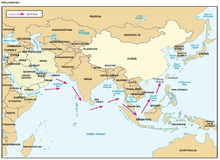 China’s Critical Sea Lines of Communication. In 2004, over 80 percent of Chinese crude oil imports transited the Straits of Malacca, with less than 2 percent transiting the Straits of Lombok.
China’s Critical Sea Lines of Communication. In 2004, over 80 percent of Chinese crude oil imports transited the Straits of Malacca, with less than 2 percent transiting the Straits of Lombok.
Strategy, plans, priorities
The People's Liberation Army Navy has become more prominent in recent years owing to a change in Chinese strategic priorities. The new strategic threats include possible conflict with the United States and/or a resurgent Japan in areas such as the Taiwan Strait or the South China Sea. As part of its overall program of naval modernization, the PLAN has a long-term plan of developing a blue water navy.[1] Current modernizations, however, represent a naval force that is best suited to cooperation rather than competition with other world powers.[22]
Robert D. Kaplan has said that it was the collapse of the Soviet Union that allowed China to transfer resources from its army to its navy and other force projection assets.[23]
China is constructing a major underground nuclear submarine base near Sanya, Hainan. In December 2007 the first Type 094 submarine was moved to Sanya.[24] The Daily Telegraph on 1 May 2008 reported that tunnels were being built into hillsides which could be capable of hiding up to 20 nuclear submarines from spy satellites. According to the Western news media the base is reportedly to help China project seapower well into the Pacific Ocean area, including challenging United States naval power.[25][26]
During a 2008 interview with the BBC, Major General Qian Lihua, a senior Chinese defense official, stated that the PLAN aspired to possess a small number of aircraft carriers to allow it to expand China's air defense perimeter.[27] According to Qian the important issue was not whether China had an aircraft carrier, but what it did with it.[27]
At the occasion of the 60th anniversary of the PLAN, 52 vessels were shown in manoeuvres off Qingdao in April 2009 including previously unseen nuclear submarines. The demonstration was seen as a sign of the growing status of China, while the CMC Chairman, Hu Jintao, indicated that China is neither seeking regional hegemony nor entering an arms race.[28]
On 13 January 2009, Adm. Robert F. Willard, head of the U.S. Pacific Command, called the PLAN's modernization "aggressive," and that it raised concerns in the region.[29] On 15 July 2009, Senator Jim Webb of the Senate Foreign Relations Committee declared that only the "United States has both the stature and the national power to confront the obvious imbalance of power that China brings" to situations such as the claims to the Spratly and Paracel islands.[30]
Ronald O'Rourke of the Congressional Research Service writes that the PLAN "continues to exhibit limitations or weaknesses in several areas, including capabilities for sustained operations by larger formations in distant waters, joint operations with other parts of China’s military, C4ISR systems, anti-air warfare (AAW), antisubmarine warfare (ASW), MCM, and a dependence on foreign suppliers for certain key ship components."[31]
In September 2011 the PLAN made further steps to a blue water navy when its first aircraft carrier, the rebuilt ex-Soviet aircraft carrier Varyag, set to sea for its first sea trials.[32]
Japan has raised concerns about the PLAN's growing capability and the lack of transparency as its naval strength keeps on expanding.[33]
2008 Anti-piracy operations
On 18 December 2008, Chinese authorities deployed People's Liberation Army Navy vessels to escort Chinese shipping in the Gulf of Aden.[34] This deployment came after a series of attacks and attempted hijackings on Chinese vessels by Somali pirates. Reports suggest two destroyers (Luyang II-Class 171 Haikou and Luyang-Class 169 Wuhan) and a supply ship are the ones being used. This move was welcomed by the international community as the warships complement a multinational fleet already operating along the coast of Africa. It will be the first time Chinese warships have deployed outside the Asia-Pacific region for a military operation since Zheng He in the 15th century. Since this operation PLAN has sought the leadership of the ‘Shared Awareness and Deconfliction’ body (SHADE), which would require an increase in the number of vessels contributing to the anti-piracy fleet.[22]
Libyan civil war
In the lead-up to the 2011 Libyan civil war, the Xuzhou was deployed from anti-piracy operations in the Gulf of Aden to help evacuate Chinese nationals from Libya.[35]
Organization
Main article: People's Liberation Army Navy OrganizationThe PLAN is organized into several departments for efficient command, control and coordination.
Ranks
Main article: Ranks of the People's Liberation Army NavyEquipment
 PLAN Type 052C air defence destroyer
PLAN Type 052C air defence destroyer
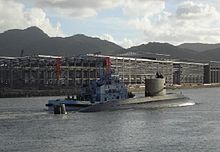 The latest Yuan-class SSK
The latest Yuan-class SSK
The PLAN initially utilized Soviet-based hardware as the backbone of their forces, with increasing domestic production over time. In the last several years, the PRC has made progress in modernizing its fleet with the purchase of Sovremenny class destroyers and Kilo class submarines, as well as producing sophisticated domestic designs such as the Lanzhou class destroyers and the Yuan class submarines.
China's submarine fleet has also made advances. The Song and Yuan-class subs are quieter than their predecessors and the Kilo-class subs are equipped with two next-generation weapons: the Klub anti-ship cruise missile and the VA-111 Shkval torpedo. Some Chinese submarines, including the Kilo and Yuan, are also thought to have air-independent propulsion, which would allow them to remain submerged for longer periods of time than they could previously maintain.
Chinese naval technology has improved, in part due to Russian assistance. Its latest destroyers use more local hardware of an improved quality, such as better fire-control systems, stealth technology in their hull designs to reduce their radar profile, and C4ISR systems.
However, despite these rapid advances, roughly half of China's major combat vessels and the bulk of the smaller vessels are still from older, obsolescent classes and not replaced by newer ones.
Inventory
Type Nr.
Planned/
BuildingNr.
Active[36]Nr. in
ReserveSubmarines Nuclear Ballistic Missile Submarines 4 1 Nuclear Attack Submarines 6 X Conventional Ballistic Missile Submarines 1 X Conventional Attack Submarines 52 X Total Submarines 63 1 Principal Surface Combatants Aircraft Carriers 1 X Destroyers 25 X Frigates 47 X Total Principal Surface Combatants 73 Coastal Warfare Vessels Missile Boats 91 X Patrol Boats 231 X Total Coastal Warfare Vessels 332 X Amphibious Warfare Vessels Landing Platforms 1 X Landing Ships 88 X Landing Craft 140 230 Total Amphibious Warfare Vessels 229 230 Mine Warfare Vessels Mine Warfare Ships 52 40 Mine Warfare Drones ? X Total Mine Warfare Vessels 52 40 Total Auxiliary/Support Vessels 219 X Total All Vessels 962 271 Total Combat Vessels 515 41 Note: "Total Combat Vessels" counts only submarines, principal surface combatants, coastal warfare vessels, mine warfare ships, landing platforms and ships. These are vessels that would normally be commissioned and excludes landing craft, mine warfare drones and auxiliary/support vessels. All numbers are approximate.
Ships
Main article: Ships of the People's Liberation Army NavySubmarines
Main article: Submarines of the People's Liberation Army NavyMain article: Naval Weaponry of the People's Liberation Army NavyMain article: People's Liberation Army Naval Air ForceFuture fleet
Main article: Chinese aircraft carrierThe PLAN's ambitions include operating out to the first and second island chains, as far as the South Pacific near Australia, and spanning to the Aleutian islands, and operations extending to the Straits of Malacca near the Indian Ocean.[37]
The future PLAN fleet will be composed of a balance of assets aimed at maximising the PLAN's fighting effectiveness. On the high end, there would be modern destroyers equipped with long range air defense missiles (Type 052B, Type 052C, Type 051C); destroyers armed with supersonic anti-ship missiles (Sovremenny class); advanced nuclear powered attack and ballistic missile submarines (Type 093, Type 094); advanced conventional attack submarines (Kilo and Yuan); aircraft carriers and large amphibious warfare vessels capable mobilizing troops at long distances. On the medium and low end, there would be more economical multi-role capable frigates and destroyers (upgraded Luda, Luhu, Jiangwei II, Jiangkai); fast littoral missile attack craft (Houjian, Houxin, Houbei); various landing ships and light craft; and conventionally powered coastal patrol submarines (Song).
The future fleet will have the obsolete combat ships (based on 1960s designs) phased out in the coming decades as more modern designs enter full production. It may take a decade for the bulk of these older ships to be retired. Until then, they will serve principally on the low end, as multi-role patrol/escort platforms. Their use could be further enhanced in the future by being used as fast transports or fire support platforms. This system of phasing out would see a reversal in the decline in quantity of PLAN vessels by 2015, and cuts in inventory after the end of the Cold War could be made up for by 2020.[38]
During 2001-2006 there has been a rapid building and acquisition program.[37] There were more than a dozen new classes of ships built in these last five years,[37] totalling some 60 brand new ships (including landing ships and auxiliaries).[37] Simultaneously, dozens of other ships have been either phased out of service or refitted with new equipment.
There had been speculation about the PLAN building or acquiring an aircraft carrier,[39] but on 23 March 2009 China's defense minister, Liang Guanglie, confirmed the country's plans to build its own aircraft carrier.[40] According to Vice Admiral David J. Dorsett of the U.S. Navy, sea trials of the refitted Varyag may start in late 2011.[41] The ex-Varyag aircraft carrier finished refurbishment on 10 August 2011, and is currently undergoing sea trials.[42]
Submarines play a significant role in the development of the PLAN's future fleet. This is made evident by the construction of a new type of nuclear ballistic missile submarine, the Type 094 and the Type 093 nuclear attack submarine. This will provide the PLAN with a more modern response for the need of a seaborne nuclear deterrent. The new submarines will also be capable of performing conventional strike and other special warfare requirements.
Ronald O'Rourke of the Congressional Research Service reported that the long term goals of PLAN planning include:
- assert or defend China’s claims in maritime territorial disputes and China’s interpretation of international laws relating to freedom of navigation in exclusive economic zones (an interpretation at odds with the U.S. interpretation);
- protect China’s sea lines of communications to the Persian Gulf, on which China relies for some of its energy imports; and
- assert China’s status as a major world power, encourage other states in the region to align their policies with China, and displace U.S. regional military influence.[43]
During the military parade on the 60th anniversary of the People's Republic of China, the YJ-62 naval cruise missile made its first public appearance; the YJ-62 represents the next generation in naval weapons technology in the PLA.
See also
References
- ^ a b "Chinese navy urged to go from coastal waters to oceans". News.xinhuanet.com. 2009-03-07. http://news.xinhuanet.com/english/2009-03/07/content_10963412.htm. Retrieved 2010-10-25.
- ^ Cole, Bernard D. The Great Wall at Sea Annapolis: Naval Institute Press, 2001
- ^ China's Navy 2007. Washington, DC: U.S. Navy. 2008. pp. 23–30. ISBN 0785227598. http://www.fas.org/irp/agency/oni/chinanavy2007.pdf. Retrieved 2010-02-25.
- ^ a b China's Navy 2007. Washington, DC: U.S. Navy. 2008. p. 114. ISBN 0785227598. http://www.fas.org/irp/agency/oni/chinanavy2007.pdf. Retrieved 2010-02-25.
- ^ Dengfeng, Wu (2009). "Deep Blue Defense – A Modern Force at Sea". Focus. China Pictorial. http://www.chinapictorial.com.cn/en/focus/txt/2009-04/07/content_190344.htm. Retrieved 2010-02-25.
- ^ Dumbaugh, Kerry; Richard Cronin, Shirley Kan, Larry Niksch, David M. Ackerman (2 February 2009, reviewd 12 November 2001). China’s Maritime Territorial Claims: Implications for U.S. Interests. Washington, DC: Congressional Research Service (CRS). pp. CRS–32. ISBN CRS Report RL31183. http://web.mit.edu/kolya/.f/root/net.mit.edu/sipb.mit.edu/contrib/wikileaks-crs/wikileaks-crs-reports/RL31183.pdf. Retrieved 2010-03-02.
- ^ Kim, Duk-ki (2000). Naval strategy in Northeast Asia: geo-strategic goals, policies, and prospects. New York, New York: Routledge. p. 152. ISBN 071464966X. http://books.google.com/?id=9ReJ6RvoeREC&pg=PA152&lpg=PA152&dq=Zhuhai+Nancang+1997&q=Zhuhai%20Nancang%201997. Retrieved 2010-03-02.
- ^ JO1 Robert Benson, USN (Fall 1997). "Chinese Navy's Historic Pearl Harbor Visit". Forum. Asian Pacific Defense (APAN). http://forum.apan-info.net/fall_97/China_r.html. Retrieved 2010-03-02.
- ^ "30 Years of Sino- US Relations". News feature. Ministry of Foreign Affairs of the People's Republic of China. 2001. http://www.fmprc.gov.cn/eng/premade/28067/sino-us6.htm. Retrieved 2010-03-03.
- ^ Graham, Euan (2005). Japan's sea lane security, 1940-2004: a matter of life and death?. New York: Institute/Routledge Japanese Studies. p. 208. ISBN 0415356407.
- ^ China's Navy 2007. Washington, DC: U.S. Navy. 2008. pp. 114–115. ISBN 0785227598. http://www.fas.org/irp/agency/oni/chinanavy2007.pdf. Retrieved 2010-02-25.
- ^ "China celebrates navy's circumnavigation". News Online. ABC News. 2002-09-23. http://www.abc.net.au/news/newsitems/200209/s683908.htm. Retrieved 2010-02-25.
- ^ "Chinese naval ships made first round-the-world sailing". Special Reports. Ministry of National Defense of the People's Republic of China. 2009-09-18. http://eng.mod.gov.cn/SpecialReports/2009-09/18/content_4089049.htm. Retrieved 2010-02-25.
- ^ "2002: Chinese naval ships made first round -the-world sailing". Yearly Focus. PLA Daily. 2008-10-08. http://english.pladaily.com.cn/site2/special-reports/2008-11/27/content_1608384.htm. Retrieved 2010-03-02.
- ^ "Chinese Naval Fleet Concludes Visit to Turkey". World News. People's Daily Online. 2002-06-24. http://english.peopledaily.com.cn/200206/23/eng20020623_98395.shtml. Retrieved 2009-03-02.
- ^ "Chinese Naval Ship Formation's First Global Navigation". Home – China. People's Daily. 2002-09-28. http://english.people.com.cn/200209/28/eng20020928_104085.shtml. Retrieved 2010-03-04.
- ^ China's Navy 2007. Washington, DC: U.S. Navy. 2008. p. 115. ISBN 0785227598. http://www.fas.org/irp/agency/oni/chinanavy2007.pdf. Retrieved 2010-02-25.
- ^ China's Navy 2007. Washington, DC: U.S. Navy. 2008. p. 116. ISBN 0785227598. http://www.fas.org/irp/agency/oni/chinanavy2007.pdf. Retrieved 2010-02-25.
- ^ "China to add special forces, helicopters to fight pirates". Shanghai Daily. 2008-12-23. http://www.shanghaidaily.com/sp/article/2008/200812/20081223/article_385590.htm. Retrieved 2009-03-27.
- ^ "China ready to use force on Somali pirates". Defencetalk.com. 2008-12-23. http://www.defencetalk.com/news/publish/navy/China_ready_to_use_force_on_Somali_pirates120016822.php. Retrieved 2009-03-27.[dead link]
- ^ Erikson, Andrew R.; Lt. Justine D. Mikolay, USN (March 2009). "Welcome China to the Fight Against Pirates". U.S. Naval Institute Proceeding 135 (3): 34–41. ISSN 0041–798X. http://www.usni.org/magazines/proceedings/story.asp?STORY_ID=1809. Retrieved 2009-04-20. "Access requires registration."
- ^ a b "Why China's Naval Rise Could Help the World". The-diplomat.com. http://www.the-diplomat.com/001f1281_r.aspx?artid=392. Retrieved 2010-10-25.
- ^ "China's Arrival: A Strategic Framework for a Global Relationship, page 50" (PDF). http://www.cnas.org/files/documents/publications/CNAS%20China%27s%20Arrival_Final%20Report.pdf. Retrieved 2010-10-25.
- ^ "Secret Sanya - China's new nuclear naval base revealed - Jane's Security News". Janes.com. 2008-04-21. http://www.janes.com/news/security/jir/jir080421_1_n.shtml. Retrieved 2010-10-25.
- ^ Harding, Thomas, "Chinese Build Secret Nuclear Submarine Base", The Daily Telegraph (London), 2 May 2008.
- ^ Harding, Thomas, "Chinese Nuclear Submarines Prompt 'New Cold War' Warning", The Daily Telegraph (London), 3 May 2008.
- ^ a b "China has aircraft carrier hopes". BBC News. 2008-11-17. http://news.bbc.co.uk/1/hi/world/asia-pacific/7732679.stm. Retrieved 2010-05-22.
- ^ Kathrin Hille (2009-04-24). "China's show of sea power challenges US". Financial Times.
- ^ "China's 'aggressive' buildup called worry". Washingtontimes.com. 2010-01-14. http://www.washingtontimes.com/news/2010/jan/14/chinas-aggressive-buildup-called-worry/. Retrieved 2010-10-25.
- ^ "US Reaffirms Its Rights to Operate in South China Sea". Voanews.com. 2009-07-16. http://www.voanews.com/english/2009-07-16-voa4.cfm. Retrieved 2010-10-25.
- ^ Ronald O’Rourke (2009-12-23). "CRS RL33153 China Naval Modernization: Implications for U.S. Navy Capabilities–Background and Issues for Congress". Congressional Research Service. http://opencrs.com/document/RL33153. Retrieved 2010-05-07.
- ^ http://www.china-defense-mashup.com/china-says-its-aircraft-carrier-succeeds-in-maiden-sea-trials.html
- ^ http://www.japantoday.com/category/politics/view/china-sea-power-concerns-new-japan-foreign-minister
- ^ "Somalia Pirates: China Deploys Navy To Gulf Of Aden Following Hijack Attempt | World News | Sky News". News.sky.com. http://news.sky.com/skynews/Home/World-News/Somalia-Pirates-China-Deploys-Navy-To-Gulf-Of-Aden-Following-Hijack-Attempt/Article/200812315185722?lpos=World_News_News_Your_Way_Region_8&lid=NewsYourWay_ARTICLE_15185722_Somalia_Pirates%3A_China_Deploys_Navy_To_Gulf_Of_Aden_Following_Hijack_Attempt. Retrieved 2010-10-25.
- ^ "Chinese navy frigate crosses Suez Canal for Libya evacuation.". Xinhua. 28 February 2011. http://news.xinhuanet.com/english2010/china/2011-02/28/c_13754235.htm. Retrieved 3 June 2011.
- ^ http://www.globalsecurity.org/military/world/china/navy.htm
- ^ a b c d Annual Report to Congress, Military Power of the People's Republic of China, Retrieved on 22 May 2008
- ^ "The Next Arms Race". Apac2020.the-diplomat.com. 2010-01-14. http://apac2020.the-diplomat.com/feature/the-next-arms-race/. Retrieved 2010-10-25.
- ^ [1][dead link]
- ^ "China confirms plans to build aircraft carrier | World | RIA Novosti". En.rian.ru. 2009-03-23. http://en.rian.ru/world/20090323/120692506.html. Retrieved 2010-10-25.
- ^ Defense Writers Group (Jan 5, 2011), VAdm. David J. Dorsett, Deputy CNO for Information Dominance (Transcript), airforce-magazine.com, http://www.airforce-magazine.com/DWG/Documents/2011/January%202011/010511dorsett.pdf, retrieved Apr 25, 2011
- ^ Kathrin Hille, 10 August 2011, China’s first aircraft carrier takes to the sea, The Financial Times
- ^ "China Naval Modernization: Implications for U.S. Navy Capabilities—Background and Issues for Congress". Opencrs.com. http://opencrs.com/document/RL33153. Retrieved 2010-10-25.
 This article incorporates public domain material from websites or documents of the Library of Congress Country Studies.
This article incorporates public domain material from websites or documents of the Library of Congress Country Studies.Sources
- "People's Liberation Army Navy: A Modern Navy with Chinese Characteristics". ONI. U.S. Navy. August 2009. http://www.fas.org/irp/agency/oni/pla-navy.pdf. Retrieved 2010-11-27.
- Ronald O'Rourke (1 October 2010). "China Naval Modernization: Implications for U.S. Navy Capabilities—Background and Issues for Congress". RL33153. Congressional Research Service. http://assets.opencrs.com/rpts/RL33153_20101001.pdf. Retrieved 2011-11-30.
External links
- Chinese naval aircraft in service
- PLAN - Chinese Defence Today
- Global Security - China
- PLA idag-PLAN (Swedish)
 People's Liberation Army (PLA)
People's Liberation Army (PLA)General Branches RegularMilitia and reserve forces · People's Armed Police (Special Police Unit · Snow Leopard Commando Unit · Immediate Action Unit · China Coast Guard)Administration StateInsignia RanksDecorationsHero's Medal · Meritorious Service MedalUniformOther topics InstitutionsContractors*China Electronics Technology Cooperation International · China Jing An Import and Export Corporation · China National Aero-Technology Import & Export Corporation · China National Electronics Import & Export Corporation · China North Industries Corporation · China Precision Machinery Import-Export Corporation · China Shipbuilding Industry Corporation · China Xinshidai Company · China Xinxing Import and Export Corporation · Poly TechnologiesMilitary / Naval history of China · List of Chinese battles
*Authorized Defense Products Dealer of PRC Missiles of the People's Republic of China
Missiles of the People's Republic of ChinaSurface-to-
SurfaceBallistic MissilesAnti-ShipDF-21D[1]YJ-85 (C-805)[1] · YJ-12 · YJ-22 · YJ-7 (C-701) · C-703 · YJ-62 (C-602) · KD-88 · YJ-4 · KD-63 · YJ-63 (C-603) · YJ-2 · YJ-1 · C-611 · XW-41DH-2000 · HN-2000 · YJ-91 · YJ-83 (C-803) · FL-7 · HY-3 (C-301) · FL-2 (C-101) · CJ-1 · YJ-12 · YJ-22 · 3M-80MBE/E Moskit (SS-N-22) · 3M-54E/E1 Klub (SS-N-27) · C-302 · C-303 · YJ-2 · YJ-1YJ-82 (C-802) · YJ-8 (C-801) · C-704 · YJ-7 (C-701) · FL-10 · C-703 · YJ-62 (C-602) · TL-10 · FL-8 · TL-1 · TL-2 · TL-6 · FL-9 · SY-2 · SY-1 · HY-4 (C-401) · HY-2 (C-201) · HY-1 · C-611 · XW-41Air-to-
SurfaceYJ-2 · YJ-1 · C-611 · XW-41 · YJ-22 · YJ-12 · BA-7 · AKD-10 · AR-1 · YJ-85 (C-805)[1] · C-704KD · YJ-7 (C-701) · C-703 · YJ-62 (C-602) · KD-88 · KD-63 · YJ-63 (C-603) · Kh-59 · Kh-29 · YJ-4 · QW-1DH-2000 · HN-2000 · YJ-91 · YJ-83 (C-803) · FL-7 · HY-3 (C-301) · FL-2 (C-101) · CJ-1 · YJ-12 · YJ-22 · 3M-80MBE/E Moskit (SS-N-22) · 3M-54E/E1 Klub (SS-N-27) · C-302 · C-303 · YJ-2 · YJ-1YJ-82 (C-802) · YJ-8 (C-801) · C-704 · YJ-7 (C-701) · FL-10 · C-703 · YJ-62 (C-602) · TL-10 · FL-8 · TL-1 · TL-2 · TL-6 · FL-9 · SY-2 · SY-1 · HY-4 (C-401) · HY-2 (C-201) · HY-1 · C-611 · XW-41 · Kh-35GB-1 · LS series · LT series · FT series · YZ-100 series · YZ-102 series · YZ-200 series · KAB-1500Kr · KAB-500KrSurface-to-
AirFJ · KT-1 · KT-2 · KT-III · HQ-18 · S-300PMU-2 · HQ-15 · S-300PMU-1 (HQ-10) · HQ-9 · KS-2 · KS-1 · HQ-12HQ-19 · HQ-18 · S-300PMU-2 · HQ-15 · S-300PMU-1 (HQ-10) · HQ-9 · FD-2000 · S-300PMU · S-300FM · HQ-12 · KS-1 · KS-2Man Portable SAMsAir-to-Air Beyond Visual Range AAMsNotes: 1. Under Development
List of Chinese missiles · People's Liberation Army Torpedoes of the People's Republic of China
Torpedoes of the People's Republic of China324mm 350mm 450mm 533mm 650mm Rocket-propelled Guided depth charge S3V* = Under Development
List of Chinese torpedoes · People's Liberation Army NavyCategories:- Military of the People's Republic of China
- People's Liberation Army Navy
Wikimedia Foundation. 2010.

